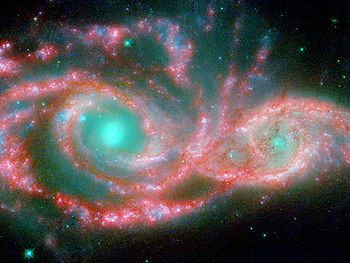
NGC 2207 and IC 2163
Encyclopedia
NGC 2207 and IC 2163 are a pair of colliding spiral galaxies about 80 million light-year
s away in the constellation
Canis Major
. Both galaxies were discovered by John Herschel
in 1835. So far three supernova
e have been observed in NGC 2207 (SN 1975A
, SN 1999ec
and SN 2003H
). NGC 2207 is in the process of tidal stripping
IC 2163.
In November 1999, the Hubble Space Telescope
took a look at these galaxies.
In April 2006, the Spitzer Space Telescope
also took a look at these galaxies (Picture seen below).

or the Mice Galaxies
, they are still two separate spiral galaxies. They are only in the first step of colliding and merging. Soon they will collide, probably looking a bit more like the Mice Galaxies
. In about a billion years time they are expected to merge and become an elliptical galaxy
.
Light-year
A light-year, also light year or lightyear is a unit of length, equal to just under 10 trillion kilometres...
s away in the constellation
Constellation
In modern astronomy, a constellation is an internationally defined area of the celestial sphere. These areas are grouped around asterisms, patterns formed by prominent stars within apparent proximity to one another on Earth's night sky....
Canis Major
Canis Major
Canis Major is one of the 88 modern constellations, and was included in the 2nd-century astronomer Ptolemy's 48 constellations. Its name is Latin for 'greater dog', and is commonly represented as one of the dogs following Orion the hunter...
. Both galaxies were discovered by John Herschel
John Herschel
Sir John Frederick William Herschel, 1st Baronet KH, FRS ,was an English mathematician, astronomer, chemist, and experimental photographer/inventor, who in some years also did valuable botanical work...
in 1835. So far three supernova
Supernova
A supernova is a stellar explosion that is more energetic than a nova. It is pronounced with the plural supernovae or supernovas. Supernovae are extremely luminous and cause a burst of radiation that often briefly outshines an entire galaxy, before fading from view over several weeks or months...
e have been observed in NGC 2207 (SN 1975A
SN 1975A
SN 1975A a supernova located in NGC 2207/IC 2163. -References:*...
, SN 1999ec
SN 1999ec
SN 1999EC is a supernova in Canis Major.-References:*...
and SN 2003H
SN 2003H
SN 2003H was a supernova that appeared halfway between the colliding NGC 2207 and IC 2163 galaxies. It was discovered January 8, 2003, by the Lick Observatory and Tenagra Supernova Searches .-References:*...
). NGC 2207 is in the process of tidal stripping
Tidal stripping
Tidal stripping occurs when a larger galaxy pulls stars and other stellar material from a smaller galaxy.Galaxies NGC 2207 and IC 2163 are in the process of tidal stripping....
IC 2163.
In November 1999, the Hubble Space Telescope
Hubble Space Telescope
The Hubble Space Telescope is a space telescope that was carried into orbit by a Space Shuttle in 1990 and remains in operation. A 2.4 meter aperture telescope in low Earth orbit, Hubble's four main instruments observe in the near ultraviolet, visible, and near infrared...
took a look at these galaxies.
In April 2006, the Spitzer Space Telescope
Spitzer Space Telescope
The Spitzer Space Telescope , formerly the Space Infrared Telescope Facility is an infrared space observatory launched in 2003...
also took a look at these galaxies (Picture seen below).

Merging galaxies
NGC 2207 is in the process of colliding and merging with IC 2163. But unlike the AntennaeAntennae Galaxies
The Antennae Galaxies are a pair of interacting galaxies in the constellation Corvus. They are currently going through a phase of starburst. They were discovered by William Herschel in 1785...
or the Mice Galaxies
Mice Galaxies
NGC 4676, or the Mice Galaxies, are two spiral galaxies in the constellation Coma Berenices. About 290 million light-years away, they are presently in the process of colliding and merging...
, they are still two separate spiral galaxies. They are only in the first step of colliding and merging. Soon they will collide, probably looking a bit more like the Mice Galaxies
Mice Galaxies
NGC 4676, or the Mice Galaxies, are two spiral galaxies in the constellation Coma Berenices. About 290 million light-years away, they are presently in the process of colliding and merging...
. In about a billion years time they are expected to merge and become an elliptical galaxy
Elliptical galaxy
An elliptical galaxy is a galaxy having an approximately ellipsoidal shape and a smooth, nearly featureless brightness profile. They range in shape from nearly spherical to highly flat and in size from hundreds of millions to over one trillion stars...
.
External links
- http://simbad.u-strasbg.fr/sim-id.pl?Ident=com%20interacting%20with%20IC%202163&Epoch1=2000%2E0&Epoch2=1950%2E0&Epoch3=2000%2E0&output%2Emes=o%2Ecatall%2C&NbIdent=1&output%2Emax=all&Equi1=2000%2E0&Equi2=1950%2E0&FrameList=FK5&Equi3=2000%2E0&Radius=10&EpochList=2000%2E0&CooFrame=FK5&Bibyear1=1983&EquiList=2000%2E0&CooEpoch=2000&Bibyear2=2006&protocol=html&output%2Emesdisp=N&CooEqui=2000&Radius%2Eunit=arcmin&Frame1=FK5&Frame2=FK4&%2Dsource=simbad&Frame3=GSIMBAD: NGC 2207]
- http://simbad.u-strasbg.fr/sim-id.pl?Ident=IC%202163&Epoch1=2000%2E0&Epoch2=1950%2E0&Epoch3=2000%2E0&output%2Emes=o%2Ecatall%2C&NbIdent=1&output%2Emax=all&Equi1=2000%2E0&Equi2=1950%2E0&FrameList=FK5&Equi3=2000%2E0&Radius=10&EpochList=2000%2E0&CooFrame=FK5&Bibyear1=1983&EquiList=2000%2E0&CooEpoch=2000&Bibyear2=2006&protocol=html&output%2Emesdisp=N&CooEqui=2000&Radius%2Eunit=arcmin&Frame1=FK5&Frame2=FK4&%2Dsource=simbad&Frame3=GSIMBAD: IC 2163]
- HST: A grazing encounter between two spiral galaxies
- APOD: Spiral Galaxies in Collision (11/9/1999)
- NGC 2207/IC 2163
- NGC 2207 at ESA/Hubble
- Spitzer Space Telescope page on NGC 2207 and IC 2163

